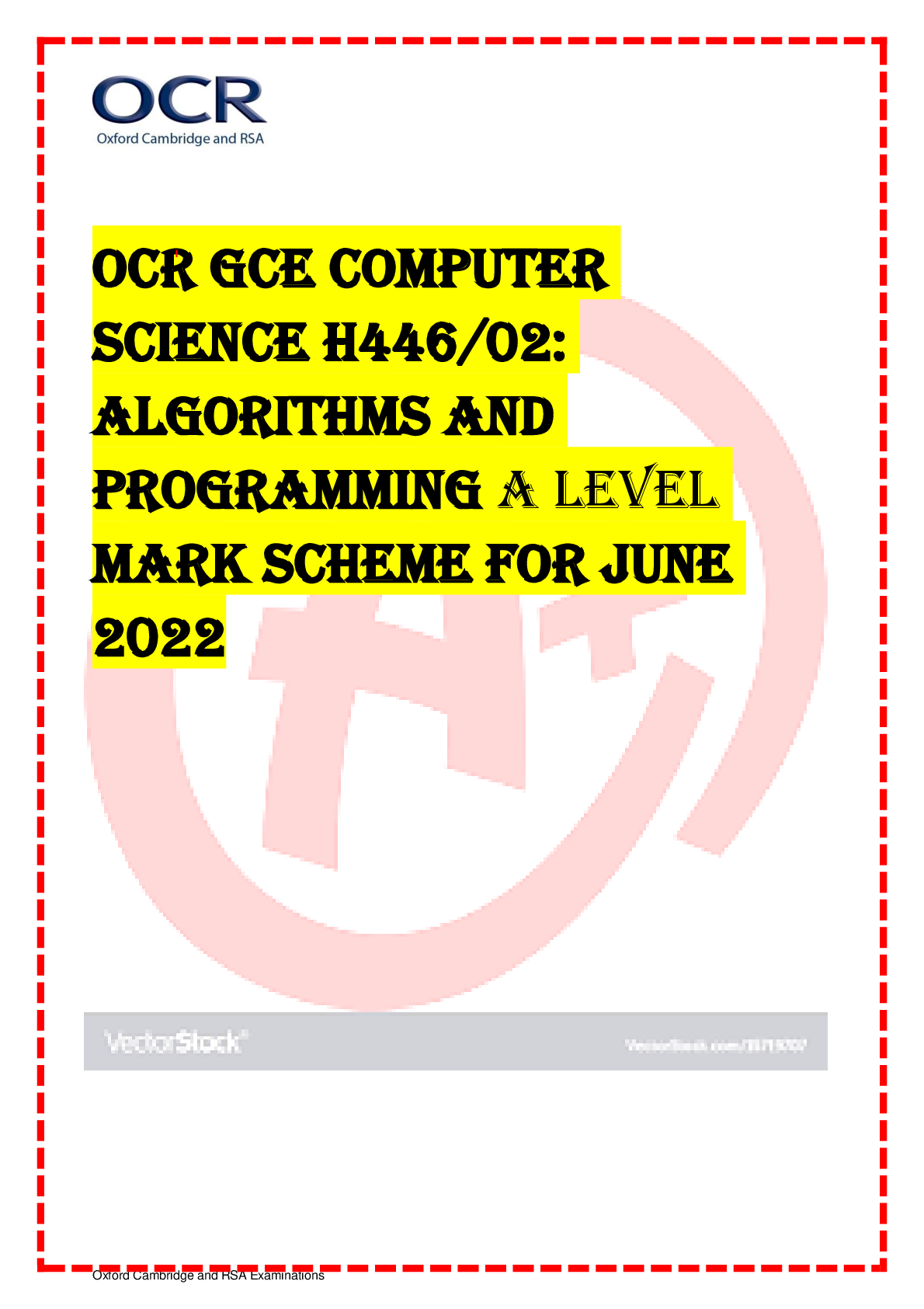Ancient History > AS Mark Scheme > GCE Ancient History H407/12: Athens and the Greek world Advanced GCE Mark Scheme for Autumn 2021 (All)
GCE Ancient History H407/12: Athens and the Greek world Advanced GCE Mark Scheme for Autumn 2021
Document Content and Description Below
Oxford Cambridge and RSA Examinations GCE Ancient History H407/12: Athens and the Greek world Advanced GCE Mark Scheme for Autumn 2021Oxford Cambridge and RSA Examinations OCR (Oxford Cambridge ... and RSA) is a leading UK awarding body, providing a wide range of qualifications to meet the needs of candidates of all ages and abilities. OCR qualifications include AS/A Levels, Diplomas, GCSEs, Cambridge Nationals, Cambridge Technicals, Functional Skills, Key Skills, Entry Level qualifications, NVQs and vocational qualifications in areas such as IT, business, languages, teaching/training, administration and secretarial skills. It is also responsible for developing new specifications to meet national requirements and the needs of students and teachers. OCR is a not-for-profit organisation; any surplus made is invested back into the establishment to help towards the development of qualifications and support, which keep pace with the changing needs of today’s society. This mark scheme is published as an aid to teachers and students, to indicate the requirements of the examination. It shows the basis on which marks were awarded by examiners. It does not indicate the details of the discussions which took place at an examiners’ meeting before marking commenced. All examiners are instructed that alternative correct answers and unexpected approaches in candidates’ scripts must be given marks that fairly reflect the relevant knowledge and skills demonstrated. Mark schemes should be read in conjunction with the published question papers and the report on the examination. © OCR 2021H407/12 Mark Scheme October 2021 Annotations Annotation Meaning Blank Page Omission Noted AO1 AO2 AO3 AO4 Irrelevant Correct point Knowledge and understanding Evaluation Subject specific guidance The Assessment Objectives targeted by each question and the maximum marks available for each Assessment Objective are given at the top of each levels mark scheme for each question. The weightings of the assessment objectives remain consistent throughout the levels. For example, if the maximum marks are 5 AO1, 10 AO2 and 15 AO3, then the AO1/AO2/AO3 ratio will be 1/2/3 throughout the levels. When marking, you must therefore give greater priority to the more heavily weighted Assessment Objective when determining in which level and where within a level to place an answer.H407/12 Mark Scheme October 2021 Section A: Relations between Greek states and between Greek and non-Greek states, 492-404 BC Question 1* To what extent do you agree that the Athenian victory in the Battle of Marathon (490 BC) changed the relationships between the Greek citystates and Persia? [30 marks] Assessment Objectives AO3 = 15 marks = Use, analyse and evaluate ancient sources within their historical context to make judgements and reach conclusions about: • historical events and historical periods studied • how the portrayal of events by ancient writers/sources relates to the historical contexts in which they were written/produced. AO2 = 10 marks = Analyse and evaluate historical events and historical periods to arrive at substantiated judgements AO1 = 5 marks = Demonstrate knowledge and understanding of the key features and characteristics of the historical periods studied. Please note that while the descriptors for AO2 and AO3 are given separately in the levels, the analysis and evaluation of sources & historical events and historical periods may be combined in responses. Additional guidance The ‘Indicative content’ is an example of historically valid content; any other historically valid content is acceptable and should be credited in line with the levels of response. Level Marks Level descriptors Indicative content Level 5 25–30 • Response uses a very good range of fully appropriate examples from the ancient sources. The sources are thoroughly analysed and evaluated, to reach logically reasoned, well-developed judgements about how the way they portray events relates to the context in which they were produced, and to draw fully substantiated and convincing conclusions about the historical issue in the question. (AO3) • The response has an excellent explanation that convincingly and very thoroughly analyses and appraises historical events and periods in order to reach substantiated, sustained, and well-developed judgements. (AO2) • The response demonstrates a very good range of accurate and detailed knowledge and a sophisticated understanding of relevant historical features and characteristics. There is a consistent focus on the question throughout the answer. (AO1) There is a well-developed and sustained line of reasoning which is coherent and logically structured. The information presented is entirely relevant and substantiated. No set answer is expected. It is possible to reach the highest marks with conclusion(s) either agreeing, disagreeing, or anywhere between providing the response has addressed the issue of extent. Responses should be marked in-line with the level descriptors. Candidates should consider the relationship between the Greek states and Persia before the Battle of Marathon (some may include the Ionian Revolt, but full discussion of this should not be expected); what happened at Marathon; examples of relationships between Greek states and the Persians after the battle. Some candidates may concentrate on the events which led up to the second invasion in 480 BC, but full credit should be given to all examples from the period of study. Answers are likely to include: • Artaphernes’ and Mardonius’ measures concerning the cities of IoniaH407/12 Mark Scheme October 2021 Level 4 19–24 • Response uses a good range of appropriate examples from the ancient sources. The sources are analysed and evaluated, to reach logically reasoned, developed judgements about how the way they portray events relates to the context in which they were produced, and to draw substantiated and convincing conclusions about the historical issue in the question. (AO3) • The response has a very good explanation that convincingly and thoroughly analyses and appraises historical events and periods in order to reach substantiated and developed judgements. (AO2) • The response demonstrates a good range of accurate and detailed knowledge and a well-developed understanding of relevant historical features and characteristics. There is a consistent focus on the question throughout the answer. (AO1) There is a well-developed line of reasoning which is clear and logically structured. The information presented is relevant and in the most part substantiated. • Athens and Eretria being the targets of the 492 expedition, but also the underlying aim of greater conquest – demand for earth and water and the various cities’ responses • Darius’ motivations for the 490 expedition, including the role of Hippias and his supporters • The effect of the result on the Greeks’ perception of the Persians • The debate at the Persian court and Xerxes’ motivations • Greek preparations during the 480s, including Themistocles • The influence of exiled Greeks on the Persians • The fear caused by Xerxes’ preparations; Greek medizers Some candidates may also discuss some of the following later events: • The aftermath of the Greek victory in 479; formation of the Delian League; the Egyptian Expedition; the Peace of Kallias; communication between Greek cities and Persia in the 420s; Persian involvement in the Ionian War Supporting source details may include: • Herodotus 6.42-3 • Herodotus 6.44, 48-9, 7.133 • The Naqs-e Rustam inscriptions; Herodotus 6.94, 107; 7.1 • Herodotus 6.112 • Herodotus 7.8-10 • Herodotus 7.144-5 • Herodotus 7.6, 102 • Herodotus 7.131-133, 138 • Thucydides 1.96; Diodorus 11.46-7, 12.2.1-2, 12.4.4-6, 12.38.2; Thucydides 1.104, 109-110; Plutarch Cimon 13.4-5; Harpokration s.v. Attikois grammasin; Herodotus 7.151; Andokides 3.29; Aristophanes Acharnians 61-71; Thucydides 8.6, 18, Xenophon Hellenica 1.4.1-7 Answers should address the idea of change and to what extent, if at all, the result of the Battle of Marathon was responsible for any change of policy on either side, or whether other events had a greater influence. Level 3 13–18 • Response uses a range of appropriate examples from the ancient sources. The sources are analysed and evaluated, to reach logically reasoned judgements about how the way they portray events relates to the context in which they were produced, and to draw supported, plausible conclusions about the historical issue in the question. (AO3) • The response has a good explanation that convincingly analyses and appraises historical events and periods in order to reach supported judgements, though these are not consistently developed. (AO2) • The response demonstrates a reasonable range of accurate and sometimes detailed knowledge and a reasonable understanding of relevant historical features and characteristics. There is a consistent focus on the question through most of the answer. (AO1) There is a line of reasoning presented with some structure. The information presented is in the most-part relevant and supported by some evidence.H407/12 Mark Scheme October 2021 Level 2 7–12 • Response uses some appropriate examples from the ancient sources. The sources are analysed and evaluated, to reach judgements about how the way they portray events relates to the context in which they were produced, and to draw some supported conclusions about the historical issue in the question. (AO3) • The response has an explanation that analyses and appraises historical events and periods, and this is linked appropriately to judgements made, though the way in which it supports the judgements may not always be made fully explicit. (AO2) • The response demonstrates a limited range of accurate knowledge and understanding of relevant historical features and characteristics, though this may lack detail. The question is generally addressed, but the response loses focus in places. (AO1) The information has some relevance but is communicated in an unstructured way. The information is supported by limited evidence, the relationship to the evidence may not be clear. Some may decide that the Greek victories in 480-79 were more influential and that nothing really changed during the 480s, or even that nothing much changed at all, but certain events meant the advantage swung back and forth throughout the fifth century. Although not expected, candidates may include non-prescribed material which should be credited. Analysis of the sources might focus on: • The methodology, agendas and contexts of the Greek and Persian sources and how these affect the value of the information • The limitations of the evidence for Persian kings and their aims, strengths and abilities which are mostly from a Greek viewpoint • Herodotus’ reliability and that of his sources of information • Herodotus’ tendency to ascribe motivation to individuals – e.g. Mardonius persuading Xerxes to attack Greece when initially he had no intention of doing so (7.5) • The ‘Greek’ nature of the Persian court debate • The limitations of the evidence for the events and issues of the period in Herodotus and Thucydides Level 1 1–6 • Response uses a limited selection of appropriate examples from the ancient sources. The sources are analysed and evaluated in a basic way, and this is linked to basic, generalised judgements about how the way they portray events relates to the context in which they were produced. There are some basic conclusions about the historical issue in the question, though these may only be implicitly linked with the analysis and evaluation of the sources. (AO3) • The response has some explanation which analyses and appraises historical events and periods in places, and this is linked appropriately to some of the judgements made, though the way in which it supports the judgements is not made explicit. (AO2) • The response demonstrates some limited knowledge and understanding of relevant historical features and characteristics, though lacking detail and in places inaccurate. The question is only partially addressed. (AO1) Information presented is basic and may be ambiguous or unstructured. The information is supported by limited evidence. 0 No response or no response worthy of creditH407/12 Mark Scheme October 2021 Question 2* Between 431 BC and 411 BC, how far did the Athenians follow the strategy suggested by Pericles at the beginning of the Peloponnesian War? [30 marks] Assessment Objectives AO3 = 15 marks = Use, analyse and evaluate ancient sources within their historical context to make judgements and reach conclusions about: • historical events and historical periods studied • how the portrayal of events by ancient writers/sources relates to the historical contexts in which they were written/produced. AO2 = 10 marks = Analyse and evaluate historical events and historical periods to arrive at substantiated judgements. AO1 = 5 marks = Demonstrate knowledge and understanding of the key features and characteristics of the historical periods studied. Please note that while the descriptors for AO2 and AO3 are given separately in the levels, the analysis and evaluation of sources & historical events and historical periods may be combined in responses. Additional guidance The ‘Indicative content’ is an example of historically valid content; any other historically valid content is acceptable and should be credited in line with the levels of response. Level Marks Level descriptors Indicative content Level 5 25–30 • Response uses a very good range of fully appropriate examples from the ancient sources. The sources are thoroughly analysed and evaluated, to reach logically reasoned, well-developed judgements about how the way they portray events relates to the context in which they were produced, and to draw fully substantiated and convincing conclusions about the historical issue in the question. (AO3) • The response has an excellent explanation that convincingly and very thoroughly analyses and appraises historical events and periods in order to reach substantiated, sustained, and well-developed judgements. (AO2) • The response demonstrates a very good range of accurate and detailed knowledge and a sophisticated understanding of relevant historical features and characteristics. There is a consistent focus on the question throughout the answer. (AO1) There is a well-developed and sustained line of reasoning which is coherent and logically structured. The information presented is entirely relevant and substantiated. No set answer is expected. It is possible to reach the highest marks with conclusion(s) either agreeing, disagreeing, or anywhere between providing the response has addressed the issue in the question. Responses should be marked in-line with the level descriptors. Candidates should consider the strategy Pericles outlines at the start of the War, give examples of the strategy the Athenians actually followed, and assess to what extent these accorded with Pericles’ advice. They may consider Thucydides’ judgement on the course of the War in 2.65. Answers are likely to include: • Pericles’ advice • Maintaining the Empire and dealing with revolts (e.g. in the Chalcidice and at Mytilene • Pylos • The expedition to central Greece and battle at Delium • Activities in the Peloponnese after the Peace of Nicias (421-418) • The Sicilian Expedition – including Nicias’ reasons for opposing it Level 4 19–24 • Response uses a good range of appropriate examples from the ancient sources. The sources are analysed and evaluated, to reach logicallyH407/12 Mark Scheme October 2021 reasoned, developed judgements about how the way they portray events relates to the context in which they were produced, and to draw substantiated and convincing conclusions about the historical issue in the question. (AO3) • The response has a very good explanation that convincingly and thoroughly analyses and appraises historical events and periods in order to reach substantiated and developed judgements. (AO2) • The response demonstrates a good range of accurate and detailed knowledge and a well-developed understanding of relevant historical features and characteristics. There is a consistent focus on the question throughout the answer. (AO1) There is a well-developed line of reasoning which is clear and logically structured. The information presented is relevant and in the most part substantiated. Supporting source details may include: • Thucydides 2.13, 2.65 • Thucydides 4.19-20, 40-41 • Thucydides 5.25-6, 43 • Thucydides Books 6 (especially 6.12-13) & 7; 8.2 Although not expected, candidates may include non-prescribed material which should be credited. Analysis of the sources might focus on: • The methodology, agendas and contexts of the Greek sources and how these affect the value of the information • Thucydides’ reliability and that of his sources of information • The limitations of the evidence for the events and issues of the period in Thucydides Level 3 13–18 • Response uses a range of appropriate examples from the ancient sources. The sources are analysed and evaluated, to reach logically reasoned judgements about how the way they portray events relates to the context in which they were produced, and to draw supported, plausible conclusions about the historical issue in the question. (AO3) • The response has a good explanation that convincingly analyses and appraises historical events and periods in order to reach supported judgements, though these are not consistently developed. (AO2) • The response demonstrates a reasonable range of accurate and sometimes detailed knowledge and a reasonable understanding of relevant historical features and characteristics. There is a consistent focus on the question through most of the answer. (AO1) There is a line of reasoning presented with some structure. The information presented is in the most-part relevant and supported by some evidence. Level 2 7–12 • Response uses some appropriate examples from the ancient sources. The sources are analysed and evaluated, to reach judgements about how the way they portray events relates to the context in which they were produced, and to draw some supported conclusions about the historical issue in the question. (AO3) • The response has an explanation that analyses and appraises historical events and periods, and this is linked appropriately to judgements made, though the way in which it supports the judgements may not always be made fully explicit. (AO2)H407/12 Mark Scheme October 2021 • The response demonstrates a limited range of accurate knowledge and understanding of relevant historical features and characteristics, though this may lack detail. The question is generally addressed, but the response loses focus in places. (AO1) The information has some relevance but is communicated in an unstructured way. The information is supported by limited evidence, the relationship to the evidence may not be clear. Level 1 1–6 • Response uses a limited selection of appropriate examples from the ancient sources. The sources are analysed and evaluated in a basic way, and this is linked to basic, generalised judgements about how the way they portray events relates to the context in which they were produced. There are some basic conclusions about the historical issue in the question, though these may only be implicitly linked with the analysis and evaluation of the sources. (AO3) • The response has some explanation which analyses and appraises historical events and periods in places, and this is linked appropriately to some of the judgements made, though the way in which it supports the judgements is not made explicit. (AO2) • The response demonstrates some limited knowledge and understanding of relevant historical features and characteristics, though lacking detail and in places inaccurate. The question is only partially addressed. (AO1) Information presented is basic and may be ambiguous or unstructured. The information is supported by limited evidence. 0 No response or no response worthy of creditH407/12 Mark Scheme October 2021 Question 3 How convincing do you find T. Buckley’s interpretation of the reasons why Athens lost the Peloponnesian War? [20 marks] Assessment Objectives AO4 = 15 marks = Analyse and evaluate, in context, modern historians’ interpretations of the historical events and topics studied. AO1 = 5 marks = Demonstrate knowledge and understanding of the key features and characteristics of the historical periods studied. Additional guidance The ‘Indicative content’ is an example of historically valid content; any other historically valid content is acceptable and should be credited in line with the levels of response. Please note that interpretations can be evaluated in the context of the wider historical debate connected with the issue or of the historical context about which the historian was writing. There is no expectation that the interpretation will be evaluated in the context of the methods or approach used by the historian, or how the interpretation may have been affected by the time in which they were writing, though credit can be given for this approach to evaluation if done in a way which is relevant to the question. A learner’s knowledge and understanding of the historical period, including the ancient sources may be credited, but only where it is presented in a way which is relevant and intrinsically linked to the analysis/evaluation/use of the interpretation, it should not be credited in isolation. Level Marks Level descriptors Indicative content Level 5 17–20 • Response has a very through and sustained analysis of the interpretation, in context, to produce a convincing and fully substantiated evaluation in relation to the question. (AO4) • The response demonstrates a very good range of accurate and detailed knowledge and a sophisticated understanding of historical features and characteristics that are fully relevant to the question. (AO1) No set answer is expected. It is possible to reach the highest marks with a conclusion either agreeing or disagreeing with the modern historians’ interpretation, or anywhere between providing the response has addressed the issue of ‘how convincing’. Responses should be marked in-line with the level descriptors. Answers should evaluate both the interpretation locating it within the wider historical debate about the issue and using their own knowledge of the ancient sources and events and periods to reach a judgement about how convincing they find the argument. In locating the interpretation within the wider historical debate, candidates might pick out the following points from the interpretation: • Lysander had realised that the Spartans could only win the war by starving the Athenians into submission • this could only be achieved by cutting off their grain supply from the Black Sea. • The inexperience of the Athenian generals and the skill of Lysander brought about the total defeat of the Athenian navy at Aegospotamoi, • After that it was only a matter of time before the Athenians, surrendered • Cyrus’ wholehearted support of the Spartans, especially in the supply of Persian gold, proved to be the decisive factor in helping the Spartans to defeat the Athenians in the Ionian War. Level 4 13–16 • Response has a through and sustained analysis of the interpretation, in context, to produce a convincing and well supported evaluation in relation to the question. (AO4) • The response demonstrates a good range of accurate and detailed knowledge and a well-developed understanding of historical features and characteristics that are fully relevant to the question. (AO1)H407/12 Mark Scheme October 2021 Level 3 9–12 • Response has a good analysis of the interpretation, in context, to produce a supported evaluation in relation to the question. (AO4) • The response demonstrates a reasonable range of accurate and sometimes detailed knowledge and a reasonable understanding of historical features and characteristics that are relevant to the question. (AO1) In evaluating the interpretation, answers might argue that this view is not convincing, pointing towards the following information / ancient sources: • Thucydides (7.27) gives the occupation of Decelea as one of the chief reasons for the decline of Athenian power • He also specifically mentions the Sicilian expedition as a mistake (2.65) • The year after the defeat in Sicily saw everyone ‘turn against Athens’ (Thucydides 8.2); this meant loss of tribute • The Athenians made other mistakes including banishing Alcibiades and condemning to death all her generals after the battle of Arginusae • Thucydides (2.65) implies that it was poor decisions on the part of the democracy, led by self-seeking politicians, which ultimately led to their defeat In evaluating the interpretation, answers might argue that this view is convincing, drawing on the following information / ancient sources: • Despite the Sicilian disaster, Athens had still held on for eight years, despite the occupation of Decelea, based on her naval control of the Aegean (Thucydides 2.65) • Athens rapidly surrendered after the final defeat of her navy at Aegospotamoi (Xenophon Hellenica 2.1.20-32) • Xenophon’s account supports the idea that this defeat was due to Lysander’s skill and the inexperience of the Athenian commanders • Cyrus recognised the importance of Lysander and refused to support the Spartans without him (Xen. Hell. 1.6.6) • The same year that Lysander was appointed (407) he secured funding from Cyrus (Xen. Hell. 1.5.1-3) and won a victory at Notion (leading to the banishment of Alcibiades) and the year he returned and Cyrus resumed payments (405) the Athenians were defeated • Candidates might mention that Buckley says it was the ‘decisive’ factor, not the only one, and construct their discussion around that. Level 2 5–8 • Response has some analysis of the interpretation, in context, to produce a partially supported evaluation in relation to the question. (AO4) • The response demonstrates a limited range of accurate knowledge and understanding of relevant historical features and characteristics, though this may lack detail. (AO1) Level 1 1–4 • Response has a basic analysis of the interpretation, with parts of the answer just describing the interpretation. Response produces a very basic evaluation in relation to the question. (AO4) • The response demonstrates some limited knowledge and understanding of relevant historical features and characteristics, though lacking detail and in places inaccurate. (AO1) 0 No response or no response worthy of creditH407/12 Mark Scheme October 2021 Section B: The Culture and Politics of Athens, c.460-c.399 BC Question 4 How useful is this passage for our understanding of how the Athenians treated their allies? [12 marks] Assessment Objectives AO1 = 6 marks = Demonstrate knowledge and understanding of the key features and characteristics of the historical periods studied. AO3 = 6 marks = Use, analyse and evaluate ancient sources within their historical context to make judgements and reach conclusions about how the portrayal of events by ancient writers/sources relates to the historical contexts in which they were written/produced. Additional guidance The ‘Indicative content’ is an example of historically valid content; any other historically valid content is acceptable and should be credited in line with the levels of response. Level Marks Level descriptors Indicative content Level 6 11–12 • The response demonstrates an excellent range of accurate and very detailed knowledge and a very sophisticated depth of understanding of historical features and characteristics that are fully relevant to the question. (AO1) • Response uses a very good range of fully appropriate examples from the set of ancient sources. The set of sources is thoroughly analysed and evaluated to reach substantiated, well-developed judgements about how the way the context in which the sources were produced impacts on them and their usefulness for the issue in the question. (AO3) No set answer is expected. It is possible to reach the highest marks with conclusion(s) either way as to the source’s usefulness to understanding the issue in question providing the response has addressed the issue of how useful the passage is. Responses should be marked inline with the level descriptors. Candidates may discuss the following information in relation to contents of the source: • What the author means by ‘good men’, ‘bad’ and ‘common people’ • The Athenians bring vexatious charges against the good men • They realise that the ruler is always hated by the ruled • If the rich and good men are in power in the allied cities the rule of the common people of Athens will last only a very short time • The Athenians deprive the good men of citizens rights take away their money, exile or execute them • The good men in Athens try to protect the good men in the allied cities • Control of allies is the basis of Athenian power; • Athenians want the allies’ money; they want to keep them weak, prevent revolts. Level 5 9–10 • The response demonstrates a very good range of accurate and detailed knowledge and a sophisticated understanding of historical features and characteristics that are fully relevant to the question. (AO1) • Response uses a good range of fully appropriate examples from the set of ancient sources. The set of sources is thoroughly analysed and evaluated to reach developed judgements about how the way the context in which the sources were produced impacts on them and their usefulness for the issue in the question. (AO3) Level 4 7–8 • The response demonstrates a good range of accurate and detailed knowledge and a well-developed understanding of historical features and characteristics that are fully relevant to the question. (AO1) • Response uses a good range of appropriate examples from the set of ancient sources. The set of sources is analysed and evaluated to reach developed judgements about how the way the context in which the sources were produced impacts on them and their usefulness for the issue in the question. (AO3)H407/12 Mark Scheme October 2021 Level 3 5–6 • The response demonstrates a reasonable range of accurate and sometimes detailed knowledge and a reasonable understanding of historical features and characteristics that are relevant to the question. (AO1) • Response uses a reasonable range of appropriate examples from the set of ancient sources. The set of sources is analysed and evaluated to make some basic judgements about how the way the context in which the sources were produced impacts on them and their usefulness for the issue in the question. (AO3) The usefulness of this passage in comparison/contrast to other sources which make reference to how the Athenians treated their allies, e.g.: • Thucydides 3.36-50 (The Mytilene Debate): Mytilene had been governed by oligarchies (‘good men’) who had revolted • Thucydides 3.36: Athenians vote to kill all adult males in Mytilene • Thucydides 3.37: Cleon claims that the Atheian empire was a tyranny and the subjects were always plotting against Athens • Thucydides 3.50: In the end they relent, but still kill more than 1,000 of those ‘chiefly responsible for the revolt’ • Old Oligarch 1.17-18: The Athenians profit from the allied cases which are tried in Athens in more than one way • Old Oligarch 3.10: the Athenians side with the ‘worst men’ in the allied cities Level 2 3–4 • The response demonstrates a limited range of accurate knowledge and understanding of relevant historical features and characteristics, though this may lack detail. (AO1) • Response uses a few appropriate examples from the set of ancient sources. The set of sources is analysed and evaluated in a basic way to make some basic judgements about how the way the context in which the sources were produced impacts on them and their usefulness for the issue in the question. (AO3) Level 1 1–2 • The response demonstrates some limited knowledge and understanding of relevant historical features and characteristics, though lacking detail and in places inaccurate. (AO1) • Response uses a few appropriate examples from the set of ancient sources. The set of sources is analysed and evaluated in a basic way but judgements about how the context in which the sources were produced impacts on them and their usefulness for the issue in the question are either not present or are not linked to analysis and are merely assertions. (AO3) 0 No response or no response worthy of creditQuestion 5* ‘The teachings of the Sophists led to a moral and political decline in Athens.’ To what extent do you agree with this view? [36 marks] Assessment Objectives AO3 = 18 marks = Use, analyse and evaluate ancient sources within their historical context to make judgements and reach conclusions about: • historical events and historical periods studied • how the portrayal of events by ancient writers/sources relates to the historical contexts in which they were written/produced. AO2 = 12 marks = Analyse and evaluate historical events and historical periods to arrive at substantiated judgements AO1 = 6 marks = Demonstrate knowledge and understanding of the key features and characteristics of the historical periods studied. Please note that while the descriptors for AO2 and AO3 are given separately in the levels, the analysis and evaluation of sources & historical events and historical periods may be combined in responses. Additional guidance The ‘Indicative content’ is an example of historically valid content; any other historically valid content is acceptable and should be credited in line with the levels of response. Level Marks Level descriptors Indicative content Level 6 31–36 • Response uses an excellent range of fully appropriate examples from the ancient sources. The sources are very thoroughly analysed and evaluated, to reach very logically reasoned and well-developed judgements about how the way they portray events relates to the context in which they were produced, and to draw fully substantiated, very convincing conclusions about the historical issue in the question. (AO3) • The response has an excellent explanation that convincingly and very thoroughly analyses and appraises historical events and periods in order to reach substantiated, sustained, and well-developed judgements. (AO2) • The response demonstrates an excellent range of accurate and very detailed knowledge and a very sophisticated depth of understanding of relevant historical features and characteristics. There is a consistent focus on the question throughout the answer. (AO1) There is a well-developed and sustained line of reasoning which is coherent and logically structured. The information presented is entirely relevant and substantiated. No set answer is expected. It is possible to reach the highest marks with conclusion(s) either agreeing, disagreeing, or anywhere between providing the response has addressed the issue of extent. Responses should be marked in-line with the level descriptors. Candidates should look at the teachings of individual sophists and Socrates, the effect of the sophists on rhetoric and hence politics, and the reception of the sophists in Athens. Answers are likely to include information on: • Gorgias • Hippias • Protagoras • Socrates, and how he claimed to be different from the sophists • The reception of the sophists as shown in contemporary and near contemporary writers especially Aristophanes, Clouds • The influence of rhetoric on politics. Level 5 25–30 • The challenges to religion and religious practices • Response uses a very good range of fully appropriate examples from the ancient sources. The sources are thoroughly analysed and evaluated, to reach logically reasoned, well-developed judgements about how the way they portray events relates to the context in which they were produced, and to draw fully substantiated and convincing conclusions about the historical issue in the question. (AO3)H407/12 Mark Scheme October 2021 • The response has a very good explanation that convincingly and thoroughly analyses and appraises historical events and periods in order to reach substantiated, sustained and developed and judgements. (AO2) • The response demonstrates a very good range of accurate and detailed knowledge and a sophisticated understanding of relevant historical features and characteristics. There is a consistent focus on the question throughout the answer. (AO1) There is a well-developed line of reasoning which is clear and logically structured. The information is relevant and in the most part substantiated. Supporting source details may include: • Aristophanes Clouds: 92-118, 814-1302 • Aristotle Rhetoric: 1402a • Euripides Hippolytus: especially 612, 902-1101 • Gorgias Encomium of Helen • Plato Apology: especially 17b-c, 18a-c, 19c-e • Plato Gorgias: 452d-e, 459b-c • Plato Hippias Major: 282b-e • Plato Protagoras: 316d-e • Plutarch Pericles 36 • Thucydides 3.38 • Xenophon Memorabilia 1.6.13 Analysis of the sources might focus on: • The nature of the sources which reflect the views of an educated elite and therefore possibly do not reflect the opinion of the majority • Aristophanes may be a contrast: comedy may well reflect the view, or distorted views, of the audience. Awareness of the context is important • Discussion of the above should be in the context of ‘extent’ • Some candidates might argue that writers who claim moral and political decline in Athens are biased and so the sophists cannot be held responsible Level 4 19–24 • Response uses a good range of appropriate examples from the ancient sources. The sources are analysed and evaluated, to reach logically reasoned, developed judgements about how the way they portray events relates to the context in which they were produced, and to draw substantiated and convincing conclusions about the historical issue in the question. (AO3) • The response has a good explanation that convincingly and fully analyses and appraises historical events and periods in order to reach substantiated and developed judgements. (AO2) • The response demonstrates a good range of accurate and detailed knowledge and a well-developed understanding of relevant historical features and characteristics. There is a consistent focus on the question throughout the answer. (AO1) There is a line of reasoning with some structure. The information presented is in the most-part relevant and supported by some evidence. Level 3 13–18 • Response uses a range of appropriate examples from the ancient sources. The sources are analysed and evaluated, to reach logically reasoned judgements about how the way they portray events relates to the context in which they were produced, and to draw supported, plausible conclusions about the historical issue in the question. (AO3) • The response has an explanation that convincingly analyses and appraises historical events and periods in order to reach supported judgements, though these are not consistently developed. (AO2) • The response demonstrates a reasonable range of accurate and sometimes detailed knowledge and a reasonable understanding of relevant historical features and characteristics. There is a consistent focus on the question through most of the answer. (AO1) The information has some relevance and is presented with limited structure. The information is supported by limited evidence.H407/12 Mark Scheme October 2021 Level 2 7–12 • Response uses some appropriate examples from the ancient sources. The sources are analysed and evaluated, to reach judgements about how the way they portray events relates to the context in which they were produced, and to draw some supported conclusions about the historical issue in the question. (AO3) • The response has an explanation that analyses and appraises historical events and periods, and this is linked appropriately to judgements made, though the way in which it supports the judgements may not always be made fully explicit. (AO2) • The response demonstrates a limited range of accurate knowledge and understanding of relevant historical features and characteristics, though this may lack detail. The question is generally addressed, but the response loses focus in places. (AO1) The information has some relevance but is communicated in an unstructured way. The information is supported by limited evidence and the relationship to the evidence may not be clear. Level 1 1–6 • Response uses a limited selection of appropriate examples from the ancient sources. The sources are analysed and evaluated in a basic way, and this is linked to some basic, generalised judgements about how the way they portray events relates to the context in which they were produced. There are some basic conclusions about the historical issue in the question, though these may only be implicitly linked with the analysis and evaluation of the sources. (AO3) • The response has some explanation which analyses and appraises historical events and periods in places, and this is linked appropriately to some of the judgements made, though the way in which it supports the judgements is not made explicit. (AO2) • The response demonstrates some limited knowledge and understanding of relevant historical features and characteristics, though lacking detail and in places inaccurate. The question is only partially addressed. (AO1) Information presented is basic and may be ambiguous or unstructured. The information is supported by limited evidence. 0 No response or no response worthy of creditH407/12 Mark Scheme October 2021 Question 6* How far do the sources allow us to assess the contribution of non-citizens to Athenian society? [36 marks] Assessment Objectives AO3 = 18 marks = Use, analyse and evaluate ancient sources within their historical context to make judgements and reach conclusions about: • historical events and historical periods studied • how the portrayal of events by ancient writers/sources relates to the historical contexts in which they were written/produced. AO2 = 12 marks = Analyse and evaluate historical events and historical periods to arrive at substantiated judgements AO1 = 6 marks = Demonstrate knowledge and understanding of the key features and characteristics of the historical periods studied. Please note that while the descriptors for AO2 and AO3 are given separately in the levels, the analysis and evaluation of sources & historical events and historical periods may be combined in responses. Additional guidance The ‘Indicative content’ is an example of historically valid content; any other historically valid content is acceptable and should be credited in line with the levels of response. Level Marks Level descriptors Indicative content Level 6 31–36 • Response uses an excellent range of fully appropriate examples from the ancient sources. The sources are very thoroughly analysed and evaluated, to reach very logically reasoned and well-developed judgements about how the way they portray events relates to the context in which they were produced, and to draw fully substantiated, very convincing conclusions about the historical issue in the question. (AO3) • The response has an excellent explanation that convincingly and very thoroughly analyses and appraises historical events and periods in order to reach substantiated, sustained, and well-developed judgements. (AO2) • The response demonstrates an excellent range of accurate and very detailed knowledge and a very sophisticated depth of understanding of relevant historical features and characteristics. There is a consistent focus on the question throughout the answer. (AO1) There is a well-developed and sustained line of reasoning which is coherent and logically structured. The information presented is entirely relevant and substantiated. No set answer is expected. It is possible to reach the highest marks with conclusion(s) either agreeing, disagreeing, or anywhere between providing the response has addressed the issue in the question. Responses should be marked in-line with the level descriptors. Candidates should look at the various classes and types of noncitizens in Athens and the contributions they made to Athenian society. They should also assess the extent to which the information we have in the sources is, or may not be, complete. Answers are likely to include information on: • Women • Metics • Slaves • The contributions all the above could make politically, socially, economically, and militarily Supporting source details may include: • Aristophanes Thesmophoriazusae 786-800, 830-842 • Euripides Hippolytus • Old Oligarch 1.10-12 • Plutarch Pericles 30, 32 • Thucydides 2.45 Level 5 25–30 • Response uses a very good range of fully appropriate examples from the ancient sources. The sources are thoroughly analysed and evaluated, to reach logically reasoned, well-developed judgements about how the way they portray events relates to the context in which they were produced, and to draw fully substantiated and convincing conclusions about the historical issue in the question. (AO3)H407/12 Mark Scheme October 2021 • The response has a very good explanation that convincingly and thoroughly analyses and appraises historical events and periods in order to reach substantiated, sustained and developed and judgements. (AO2) • The response demonstrates a very good range of accurate and detailed knowledge and a sophisticated understanding of relevant historical features and characteristics. There is a consistent focus on the question throughout the answer. (AO1) There is a well-developed line of reasoning which is clear and logically structured. The information is relevant and in the most part substantiated. • Xenophon Memorabilia 2.2.2 • Xenophon Poroi 2,1-2, 5 • Metics’ roles in architecture- Pheidias, Parrhasius Pausanias 1.28.2 Analysis and evaluation of the sources might focus on: • The nature of the sources which are all male, and mostly contemporary Athenian citizens (an exception being Plutarch) • Plays were performed by male actors (even female parts) before predominantly male citizen audiences, but can highlight or satirize existing views and behaviours • Discussion of the above should be in the context of ‘how far … allow’ Level 4 19–24 • Response uses a good range of appropriate examples from the ancient sources. The sources are analysed and evaluated, to reach logically reasoned, developed judgements about how the way they portray events relates to the context in which they were produced, and to draw substantiated and convincing conclusions about the historical issue in the question. (AO3) • The response has a good explanation that convincingly and fully analyses and appraises historical events and periods in order to reach substantiated and developed judgements. (AO2) • The response demonstrates a good range of accurate and detailed knowledge and a well-developed understanding of relevant historical features and characteristics. There is a consistent focus on the question throughout the answer. (AO1) There is a line of reasoning with some structure. The information presented is in the most-part relevant and supported by some evidence. Level 3 13–18 • Response uses a range of appropriate examples from the ancient sources. The sources are analysed and evaluated, to reach logically reasoned judgements about how the way they portray events relates to the context in which they were produced, and to draw supported, plausible conclusions about the historical issue in the question. (AO3) • The response has an explanation that convincingly analyses and appraises historical events and periods in order to reach supported judgements, though these are not consistently developed. (AO2) • The response demonstrates a reasonable range of accurate and sometimes detailed knowledge and a reasonable understanding of relevant historical features and characteristics. There is a consistent focus on the question through most of the answer. (AO1)H407/12 Mark Scheme October 2021 The information has some relevance and is presented with limited structure. The information is supported by limited evidence. Level 2 7–12 • Response uses some appropriate examples from the ancient sources. The sources are analysed and evaluated, to reach judgements about how the way they portray events relates to the context in which they were produced, and to draw some supported conclusions about the historical issue in the question. (AO3) • The response has an explanation that analyses and appraises historical events and periods, and this is linked appropriately to judgements made, though the way in which it supports the judgements may not always be made fully explicit. (AO2) • The response demonstrates a limited range of accurate knowledge and understanding of relevant historical features and characteristics, though this may lack detail. The question is generally addressed, but the response loses focus in places. (AO1) The information has some relevance but is communicated in an unstructured way. The information is supported by limited evidence and the relationship to the evidence may not be clear. Level 1 1–6 • Response uses a limited selection of appropriate examples from the ancient sources. The sources are analysed and evaluated in a basic way, and this is linked to some basic, generalised judgements about how the way they portray events relates to the context in which they were produced. There are some basic conclusions about the historical issue in the question, though these may only be implicitly linked with the analysis and evaluation of the sources. (AO3) • The response has some explanation which analyses and appraises historical events and periods in places, and this is linked appropriately to some of the judgements made, though the way in which it supports the judgements is not made explicit. (AO2) • The response demonstrates some limited knowledge and understanding of relevant historical features and characteristics, though lacking detail and in places inaccurate. The question is only partially addressed. (AO1) Information presented is basic and may be ambiguous or unstructured. The information is supported by limited evidence. 0 No response or no response worthy of creditOCR (Oxford Cambridge and RSA Examinations) The Triangle Building Shaftesbury Road Cambridge CB2 8EA [Show More]
Last updated: 1 year ago
Preview 1 out of 20 pages

Reviews( 0 )
Document information
Connected school, study & course
About the document
Uploaded On
Oct 10, 2022
Number of pages
20
Written in
Additional information
This document has been written for:
Uploaded
Oct 10, 2022
Downloads
0
Views
88








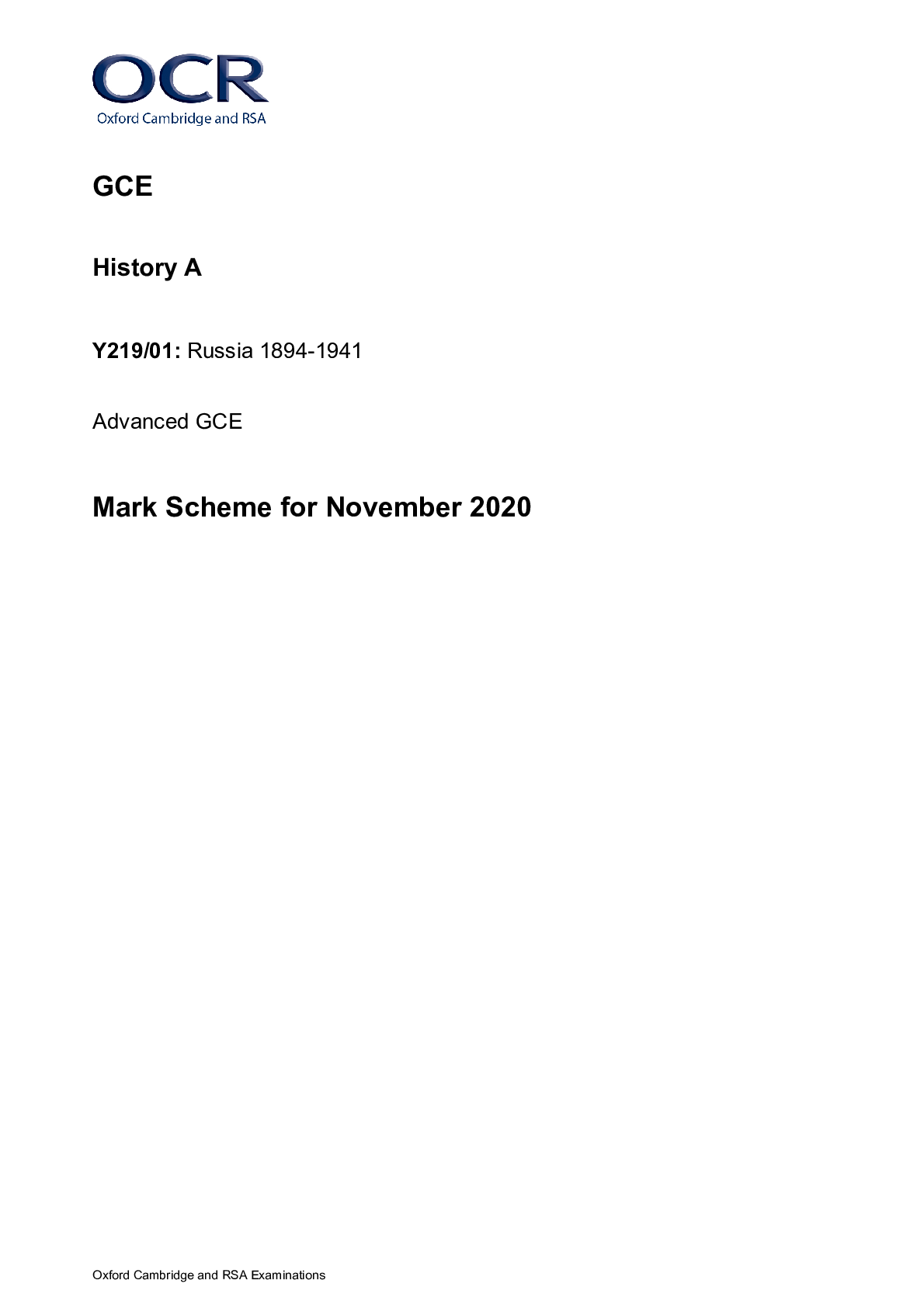
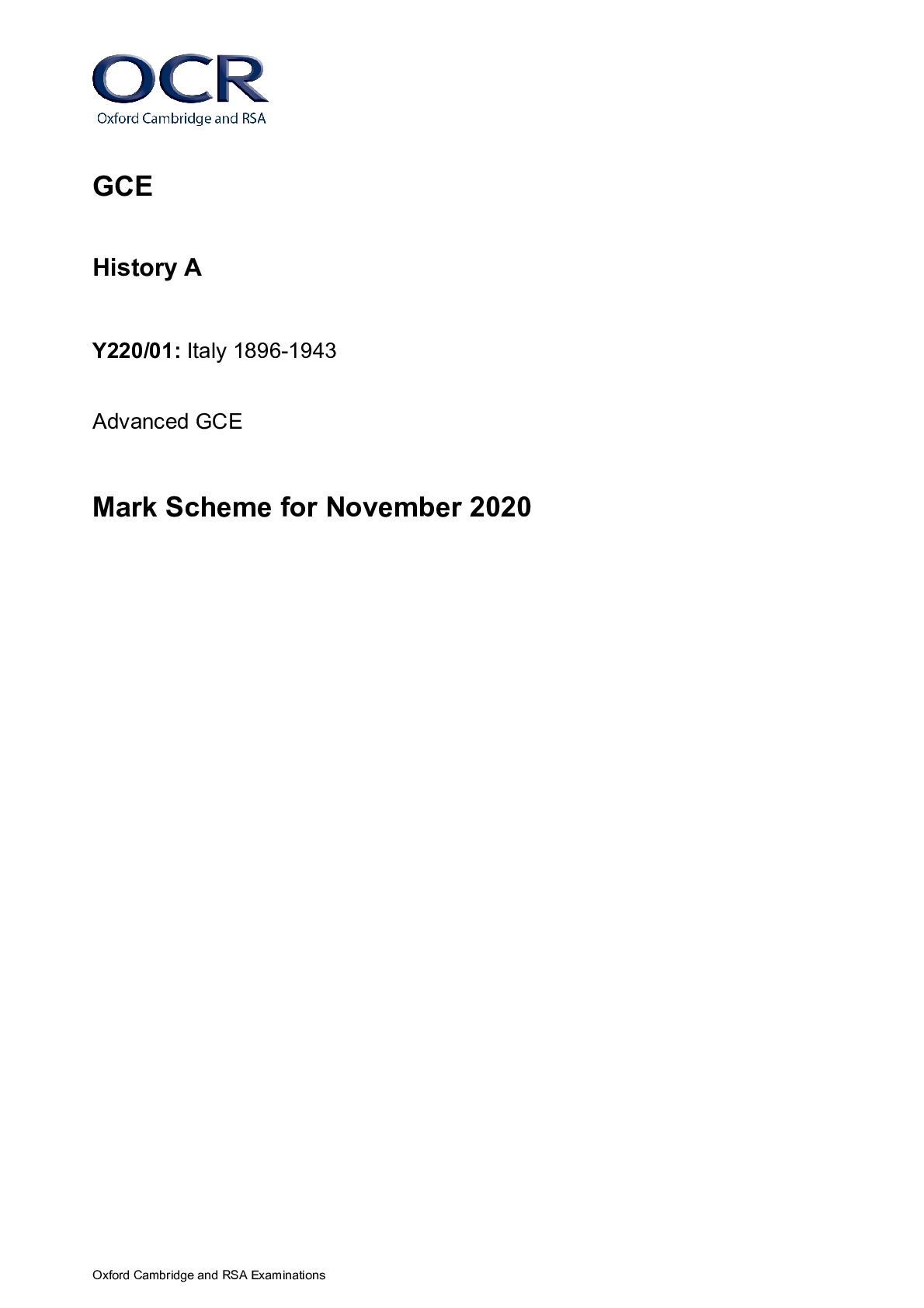

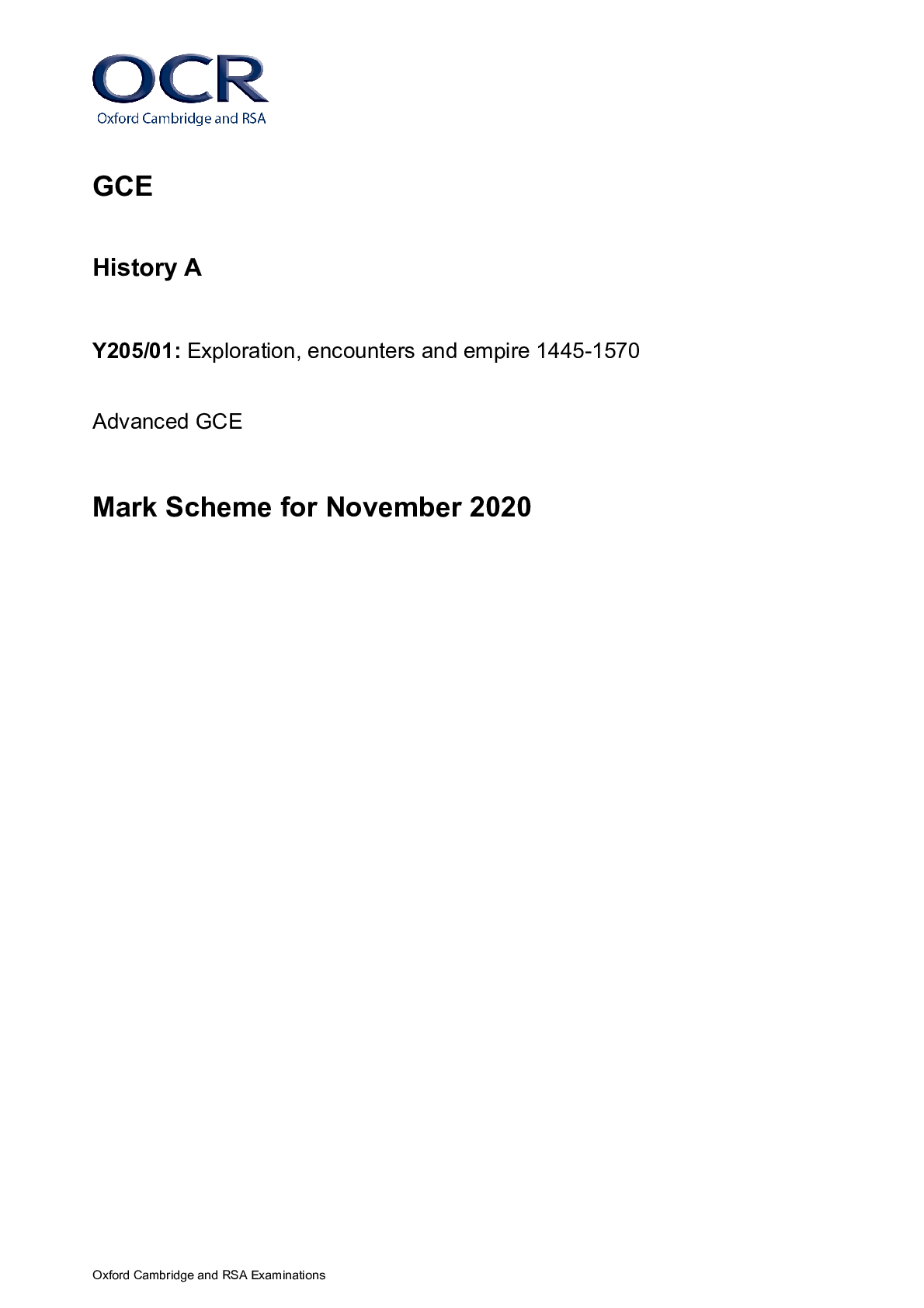
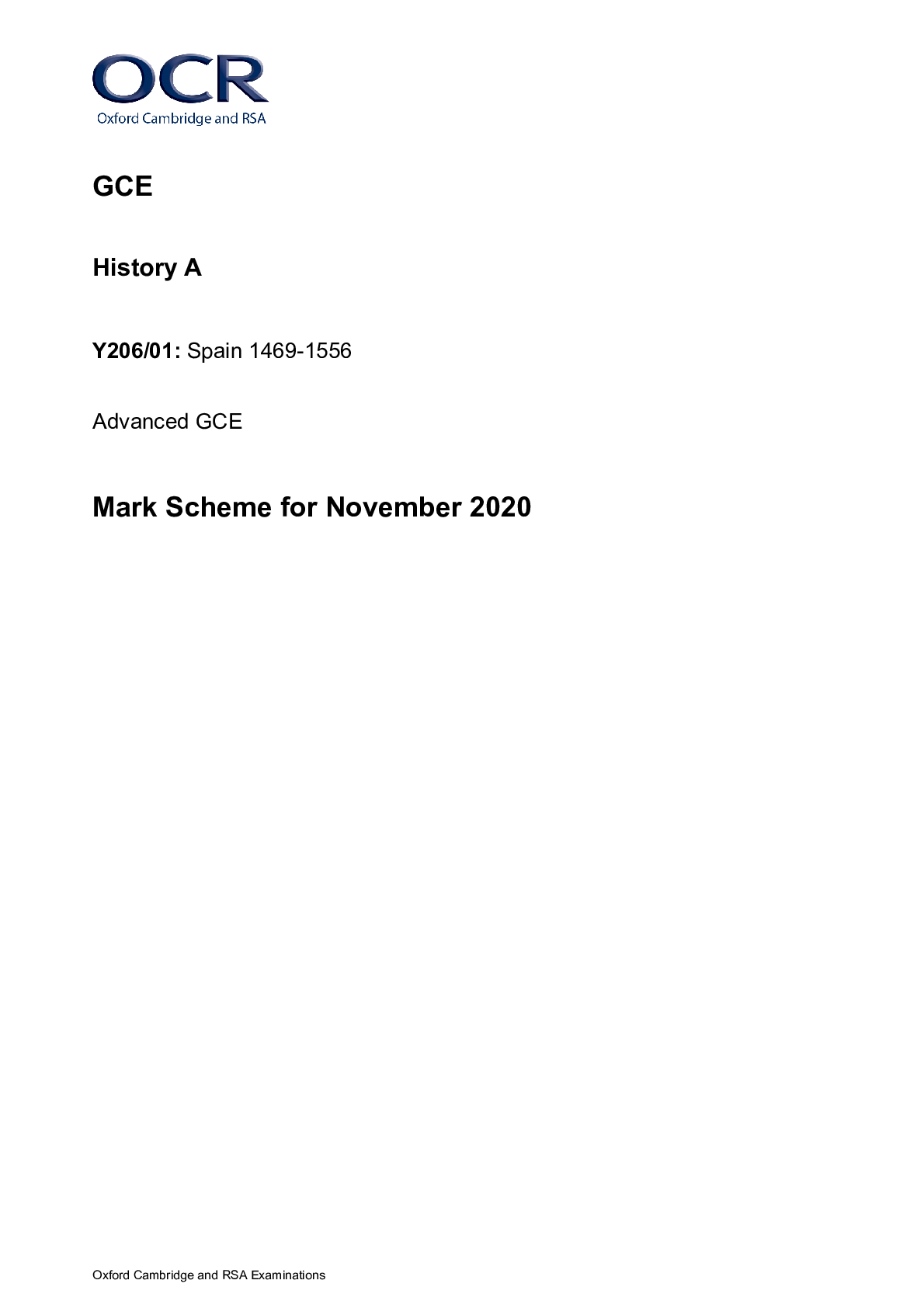
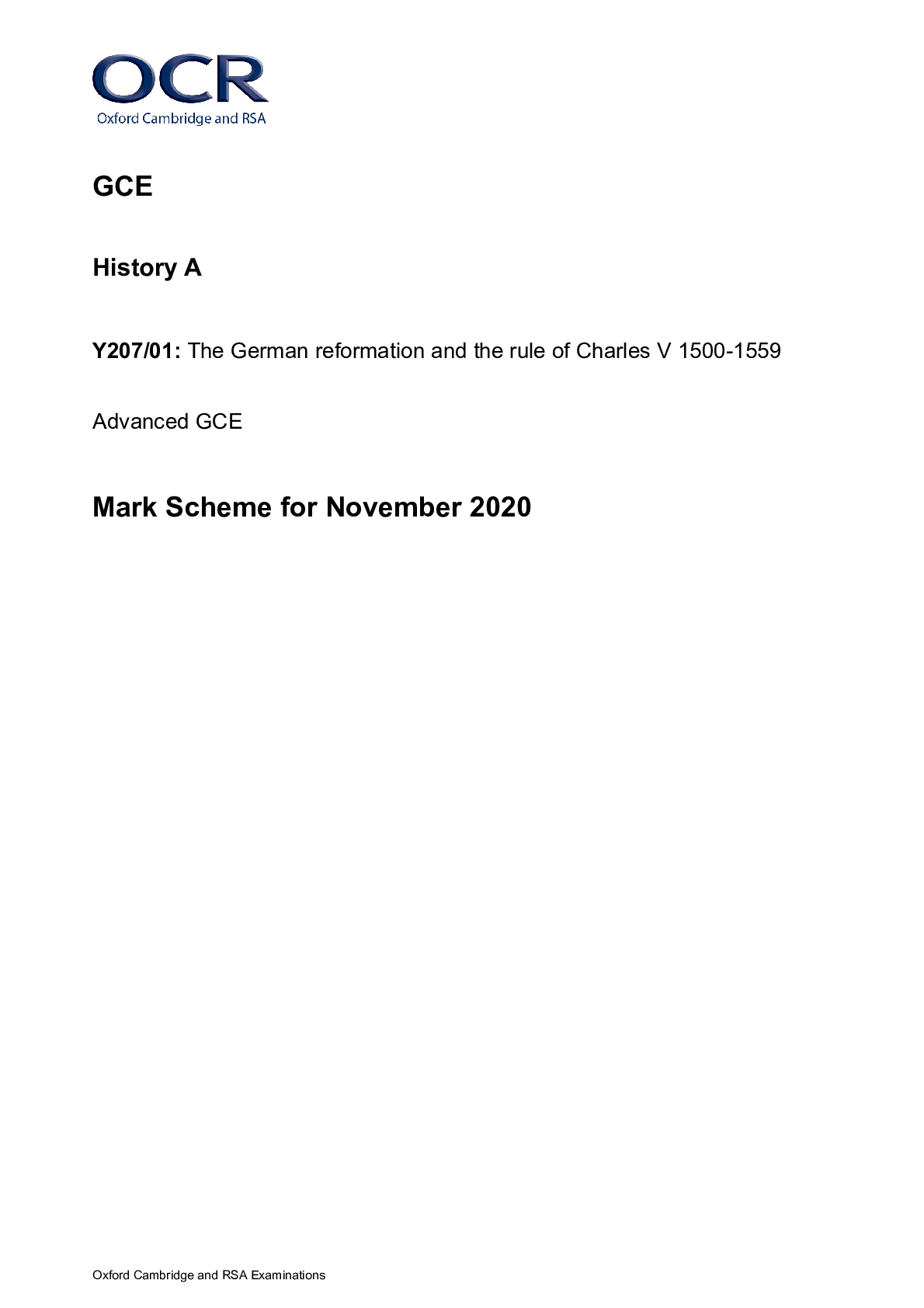
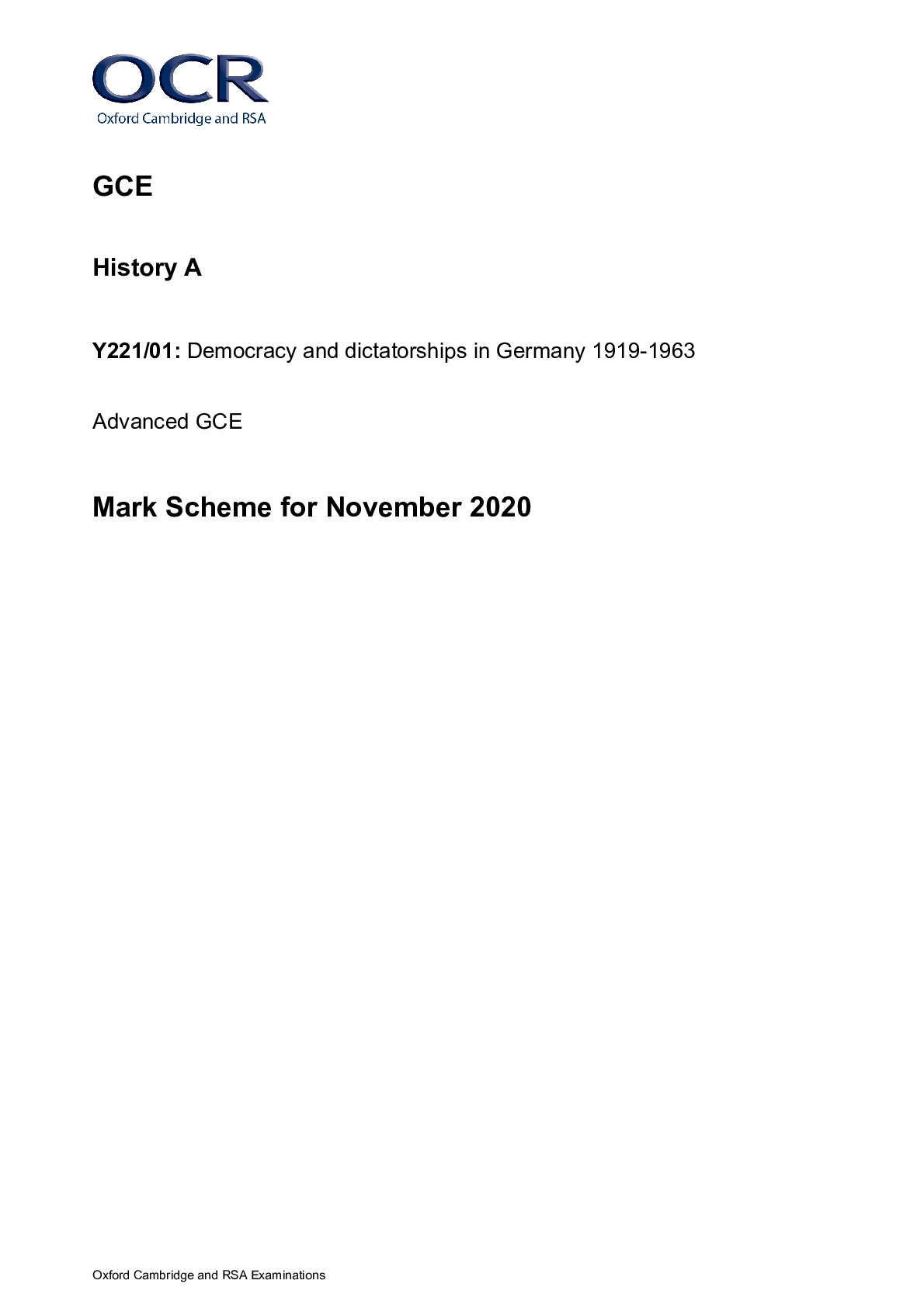

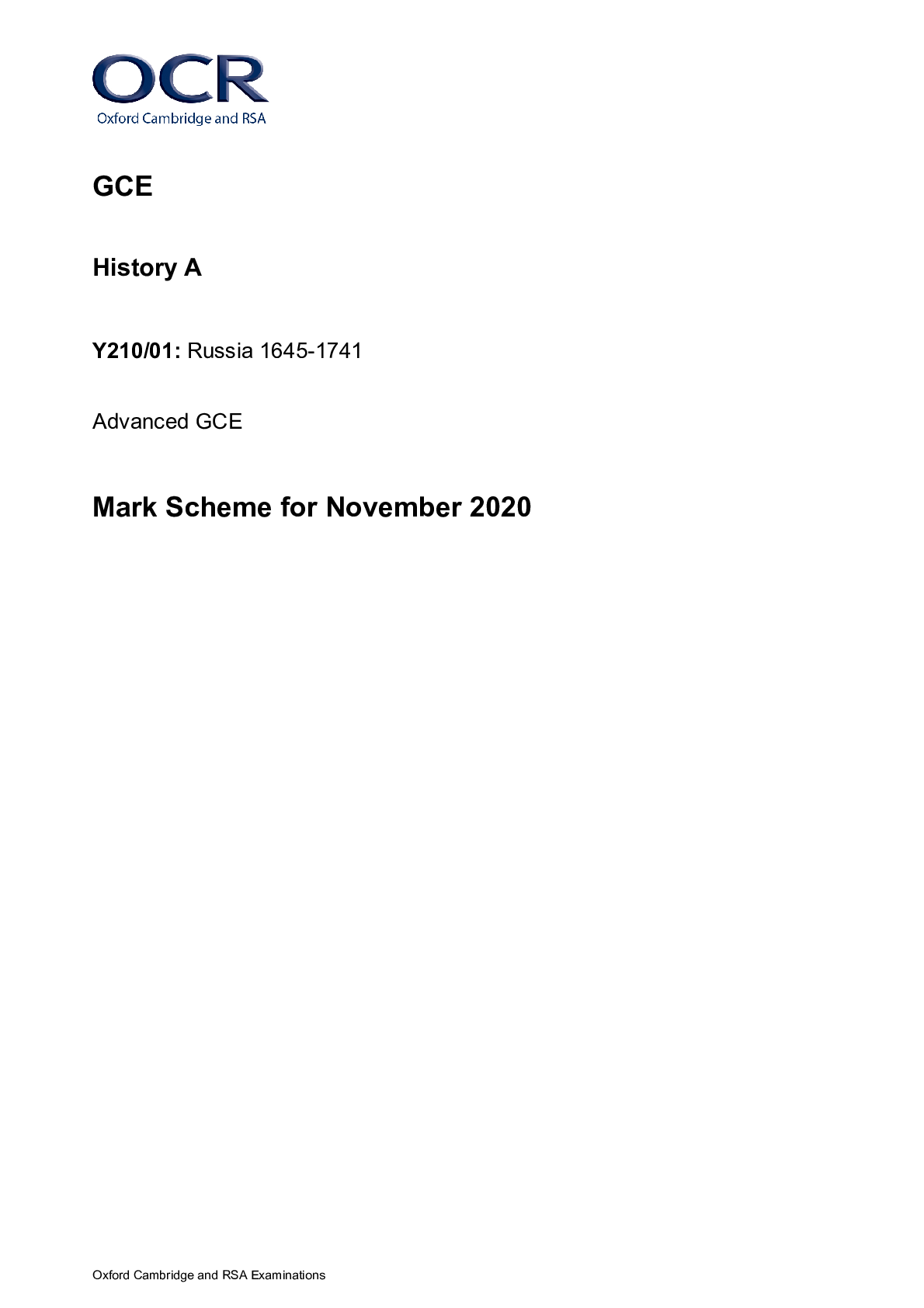


.png)



